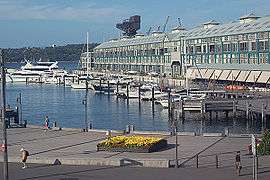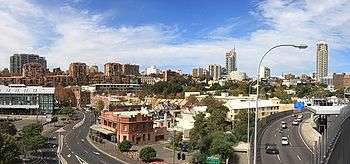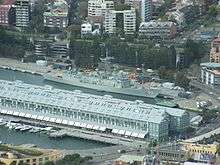Woolloomooloo
Woolloomooloo (/ˈwʊlʊmʊluː/ WUUL-uu-muu-loo) is a harbourside, inner-city eastern suburb of Sydney, New South Wales, Australia. Woolloomooloo is 1.5 kilometres east of the Sydney central business district, in the local government area of the City of Sydney. It is in a low-lying, former docklands area at the head of Woolloomooloo Bay, on Sydney Harbour. The Domain sits to the west, the locality of East Sydney is near the south-west corner of the suburb and the locality of Kings Cross is near the south-east corner. Potts Point is immediately to the east.
| Woolloomooloo Sydney, New South Wales | |||||||||||||||
|---|---|---|---|---|---|---|---|---|---|---|---|---|---|---|---|
 Woolloomooloo Bay and Finger Wharf | |||||||||||||||
| Population | 4,011 (2016 census)[1] | ||||||||||||||
| • Density | 8,000/km2 (20,800/sq mi) | ||||||||||||||
| Postcode(s) | 2011 | ||||||||||||||
| Area | 0.5 km2 (0.2 sq mi) | ||||||||||||||
| Location | 1.5 km (1 mi) east of Sydney CBD | ||||||||||||||
| LGA(s) | City of Sydney | ||||||||||||||
| State electorate(s) | Sydney | ||||||||||||||
| Federal Division(s) | Sydney | ||||||||||||||
| |||||||||||||||
Woolloomooloo was originally a working-class district of Sydney and has only recently changed with gentrification of the inner city areas of Sydney. The redevelopment of the waterfront, particularly the construction of the housing development on the Finger Wharf, has caused major change. Areas of public housing (Housing NSW a.k.a. "Housing Commission") still exist in the suburb.
History
Aboriginal culture
The current spelling of Woolloomooloo is derived from the name of the first homestead in the area, Wolloomooloo House, built by the first landowner John Palmer. There is debate as to how Palmer came up with the name with different Aboriginal words being suggested. Anthropologist J.D. McCarthy wrote in 'NSW Aboriginal Places Names', in 1946, that Woolloomooloo could be derived from either Wallamullah, meaning place of plenty or Wallabahmullah, meaning a young black kangaroo.[2]
In 1852, the traveller Col. G.C. Mundy wrote that the name came from Wala-mala, meaning an Aboriginal burial ground. It has also been suggested that the name means field of blood, due to the alleged Aboriginal tribal fights that took place in the area, or that it is from the pronunciation by Aborigines of windmill, from the one that existed on Darlinghurst ridge until the 1850s.

European settlement
After the First Fleet's arrival in Sydney, the area was initially recognised as Garden Cove or Garden Island Cove after the nearby small wooded Garden Island, off the shore. The first land grant was given to John Palmer in 1793 to allow him to run cattle for the fledgling colony.
In the 1840s the farm land was subdivided into what is now Woolloomooloo, Darlinghurst and parts of Surry Hills. Originally the area saw affluent residents building grand houses, many with spectacular gardens, attracted by the bay and close proximity to the city and Government House.[3]
The area slowly started to change after expensive houses were built in Elizabeth Bay and further east and a road was needed from Sydney. It was for this reason that William Street was built, dividing the land for the first time.
Trams
The Woolloomooloo tram line opened in stages between 1915 and 1918. This line branched off from Park Street and ran north along Haig Avenue, St John Young Crescent and Lincoln Crescent to Brown's Wharf at Woolloomooloo. Through service ran from Circular Quay via Elizabeth and Park Streets. The line was an early closure, in 1935, being replaced by a bus service from Pyrmont.
Green ban
In February 1973, the Builders Labourers Federation placed a two-year long green ban on the suburb to stop the destruction of low-income housing and trees. It succeeded and 65% of the houses were placed under rent control.[4]
Heritage listings
Woolloomooloo has a number of heritage-listed sites, including:
- Cowper Wharf Road: Finger Wharf[5]
- 43-51 Cowper Wharf Road: The Gunnery, Woolloomooloo[6]
Population
According to the 2016 census of Population, there were 4,011 people in Woolloomooloo.
- Aboriginal and Torres Strait Islander people made up 3.1% of the population.
- 45.4% of people were born in Australia. The most common countries of birth were England 6.3% and New Zealand 3.3%.
- 61.8% of people only spoke English at home. Other languages spoken at home included Mandarin 2.6%.
- The most common responses for religion were No Religion 38.7% and Catholic 19.3%.[1]
Landmarks

Woolloomooloo is home to the Finger Wharf, known for its remarkable size. It is 400 metres (1,310 ft) long and 63 m (210 ft) wide and stands on 3,600 piles.
The Sydney Harbour Trust built the Finger Wharf, or Woolloomooloo Wharf, between 1911 and 1915 with the charter to bring order to Sydney Harbour's foreshore facilities. The wharf became the largest wooden structure in the world. The area's commerce was dominated by shipping at the wharf and by the regular influx of sailors and officers from the Garden Island base of the Royal Australian Navy.
The wharf's influence diminished for Woolloomooloo during the 1970s when other more modern wharves were preferred. By the 1980s the wharf lay derelict and empty and in 1987, the state government decided to demolish the Wharf.[7] A new complex was approved to replace the wharf in Woolloomooloo Bay, but when demolition work was due to begin in January 1991, locals blocked entrance to the site.[8] Unions imposed a green ban, which stopped demolition crews from undertaking work.[8]

In the mid-1990s the wharf was renovated into 300 private residential apartments and a boutique hotel with 104 guestrooms. It also has several restaurants and bars, including the popular Water Bar, frequented by many visiting celebrities. At first, the hotel was launched as "W Sydney - Woolloomooloo" and was the W Hotels brands' first internationally launched property outside of the United States. The hotel's licensing expired in 2007 and rebranded as "Blue Hotel", managed by Taj Hotels & Resorts. Notable residents include actor Russell Crowe, who lives in a $14 million penthouse which as a result has become famous in Australia and abroad and one of the most expensive and sought after places in the country. Another prominent resident is controversial former Australian radio presenter John Laws.[9]
The Andrew "Boy" Charlton Pool, sits on the western side of Woolloomooloo Bay, amongst the Royal Botanic Gardens.
Popular culture
- The Bushwackers play a song Woolloomooloo Lair about an inhabitant of the suburb.[10]
- Steve Mullins recorded Woolloomooloo in 1910 for Jumbo Records in the UK.[11]
- The Tommy Leonetti song "My City Of Sydney", later covered by the post-punk band XL Capris, mentions "That little church steeple in Woolloomooloo."
- The Bruces sketch by Monty Python is set in the fictitious University of Woolloomooloo, mainly due to its typical Australian name.
- In the show Flight of the Conchords, Jemaine claims that his short-time girlfriend Keitha (Unnatural Love) is from Woolloomooloo
- The 1984 album Zoolook by Jean Michel Jarre has a track titled "Wooloomooloo" [sic].
- In 1970, Australian educator, journalist and politician Irina Dunn created the phrase "A woman needs a man like a fish needs a bicycle," scribbling the phrase on two bathroom doors: one at Sydney University where she was then a student, and the other at Soren's Wine Bar in Woolloomooloo. The quip is often incorrectly attributed to American feminist Gloria Steinem.[12]
- The 1982 album Circus Animals by Cold Chisel contains the song "Numbers Fall", which refers to Forbes Street and Springfield Avenue, Woolloomooloo. "Letter to Alan", on the same album, also refers to the Wayside Chapel in neighbouring Potts Point.
- The 1989 album The Big Don't Argue by Weddings Parties Anything contains the song "Ticket in Tatts", which refers to Woollomooloo.
- The popular children's book The Kangaroo from Wooloomooloo (written by Joy Cowley; illustrated by Rodney McRae, 1985), featured , among a wide variety of other Australian fauna, a kangaroo from Woolloomooloo.
- Author/Musician and sometime resident Nathan Roche set his novels "Vagrer", "Cleaning Off The Cobwebs On The Skeletons In The Closet" and "The Harbour Review" in the suburb and also wrote the song "Sailors Into Woolloomooloo" which appeared on his 2013 record, "Watch It Wharf"
- In the Dutch city of Utrecht, a student's disco is called "Woolloomooloo", or "Woo" in brief.
- "Slow Motion Angreza" song featuring Farhan Akhtar and Rebecca Breeds in movie Bhaag Milkha Bhaag have reference of Woollomooloo in lyrics.
Notable residents

- Mark Bosnich, a former Socceroos football player
- Russell Crowe, an actor[13]
- Alessandro Del Piero, a former Sydney FC football player
- Delta Goodrem, a singer
- John Laws, a former radio presenter
Notes
- Australian Bureau of Statistics (27 June 2017). "Woolloomooloo". 2016 Census QuickStats. Retrieved 2 July 2017.

- Farwell, George (1971). Requiem for Woolloomooloo. Hodder and Stoughton. ISBN 0-340-15777-1.
- Fahey, Warren. "Australian Folklore Unit". Retrieved 31 December 2006.
- Burgmann, Verity and Meredith (2011). "Green Bans movement".
- "Woolloomooloo Finger Wharf". New South Wales State Heritage Register. Office of Environment and Heritage. H01437. Retrieved 18 May 2018.
- "The Gunnery". New South Wales State Heritage Register. Office of Environment and Heritage. H00927. Retrieved 18 May 2018.
- "The Finger Wharf History". Maju Sequence. Retrieved 11 February 2007.
- Susskind, Anne (15 January 1991). "Live and let lie policy for wharf". The Sydney Morning Herald. p. 2. ISSN 0312-6315.
- Sams, Christine (1 June 2003). "On the move with Russell and Danielle". Sun-Herald. Retrieved 22 October 2006.
- G.H.Grainger. "Woolloomooloo Lair". www.grainger.de. Retrieved 18 April 2018.
- National Film and Sound Archive: Does your town have its own song?
- Allen, John S. "The Definitive Word on the Origin". A Bit of Herstory. The Fish and Bicycle Page.
I scribbled the phrase on the backs of two toilet doors, would you believe, one at Sydney University where I was a student, and the other at Soren's Wine Bar at Woolloomooloo, a seedy suburb in south Sydney.
- Macken, Lucy (5 February 2017). "Russell Crowe pulls his Finger Wharf apartment off the market, says no to $25m". domain.com.au. Retrieved 5 February 2017.
External links
| Wikimedia Commons has media related to Woolloomooloo, New South Wales. |
- SYDNEY.com - Potts Point and Woolloomooloo
- Shirley Fitzgerald - City of Sydney History Unit (2008). "Woolloomooloo". Dictionary of Sydney. Retrieved 29 September 2015. [CC-By-SA]